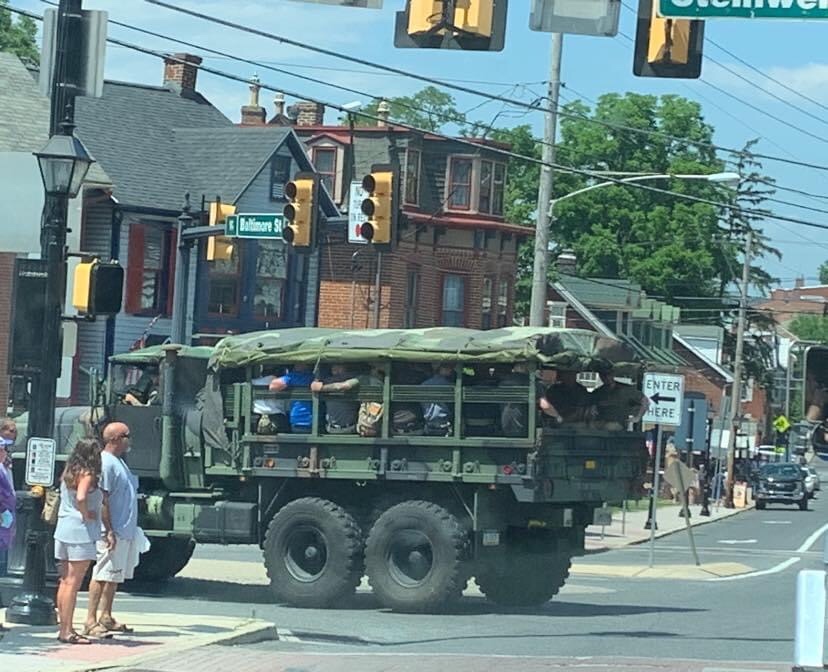By now you’ve probably seen what happened in Gettysburg this weekend. A loose network of right-wing extremist groups deployed around the battlefield and Gettysburg National Cemetery to “protect” monuments from an antifa plot that included, depending on who you ask, flag burning, monument desecration, and facepainting for children. Although local antifa members denied the rumors and the whole thing reeked of being a hoax, the so-called militias took credit for scaring away the imaginary protesters and “defending America.” Meanwhile, locals and tourists with a different perspective experienced what amounted to an unwanted occupation. For full disclosure, I wasn’t in Gettysburg this weekend—since I live downtown, I decided to spend the Fourth with my family in Dauphin County.
This is at least the fourth major right-wing demonstration since I moved to Gettysburg 8 years ago. The first was a Klan rally in 2013 organized by a man who sought to rebrand the KKK but was later sentenced to 4 years in prison after firing his gun at the Charlottesville Unite the Right Rally. The second was the First Annual Confederate Flag day in 2016, which resulted in a local museum labeling counter-protesters from Gettysburg College as terrorists. The third was a gathering of extremist militia groups in 2017, at which the only casualty was an armed demonstrator shooting himself in the foot. Saturday was unsurprising in a way, but it was no less disturbing.
Gettysburg has a long tradition of being a flashpoint in the battle for American identity, from a massive Klan rally in the 1920s, to FDR’s reconciliationist dedication of the Peace Light, to the erection of Confederate monuments as an act of defiance against the Civil Rights Era. Although the purpose of recent right-wing demonstrations is to assert an ideological claim to Gettysburg, this place does not belong to them. They do not represent the diversity of Americans—and others—from across the world for whom this place holds special meaning.
They don’t even represent the range of views of those of us who live in Gettysburg. Last month, 300 Gettysburgians turned out in Lincoln Square for a Black Lives Matter protest. Just days ago, Gettysburg, South Dakota, started removing the Confederate flag from its police department branding after community protests and a letter from Gettysburg, Pennsylvania, explaining why our borough doesn’t use that imagery. Gettysburg is a diverse community of patriotic Americans, and we should call this weekend the same thing we did the first time outsiders with guns and secessionist flags came to town: an invasion. It certainly wasn’t a celebration of American patriotism. That explanation falls apart when you see pictures of Klan flags on the battlefield and the Confederate flag on Cemetery Hill—where it never reached during the battle.
Although monuments are coming down elsewhere, I haven’t noticed much of a push for it in Gettysburg beyond rumors circulating among conservatives that we’ll be next. I doubt it. Historians have advocated additional educational context on the battlefield, but it seems like the historical setting makes for less urgency to remove the monuments than those on grounds of public buildings and non-historical parks. And that makes sense—after all, even the most vile monuments are manifestations of the deeper inequalities that BLM, the NAACP, activists, and others seek to redress. Despite conservative paranoia, battlefield monuments aren’t the priority.
Finding the right response to a moment like this is difficult. The militias at Gettysburg demonstrated under the protection of the First and Second Amendments (as did a group of armed demonstrators who marched against Stone Mountain the same day). But the battlefield is public land that belongs equally to those who the demonstration was intended to intimidate, including local counter-protesters adding their own context to secessionist monuments or simply wearing a Black Lives Matter shirt. With the appropriate permits, even flag burning is a constitutional exercise of free speech that militias have no right to prevent.
So what then can we do? In the long run, we’ll need to replace presidential dog-whistles with well-funded strategies to deradicalize and marginalize extremists. This is critical and urgent in light of the known impact of economic recession and political polarization on right-wing extremism. In the meantime, the rest of us must hold the high ground and refuse to cede the meaning of our hallowed spaces to those who would weaponize them against our fellow Americans.
The unfinished work, as Lincoln put it, remains unfinished. It is ours to continue to advance.

One reply on “Not the Last Invasion: Right-Wing Extremists Descend on Gettysburg”
[…] of Gettysburg, we have this post about the incident. “By now you’ve probably seen what happened in Gettysburg this […]